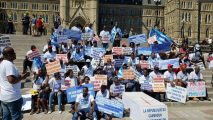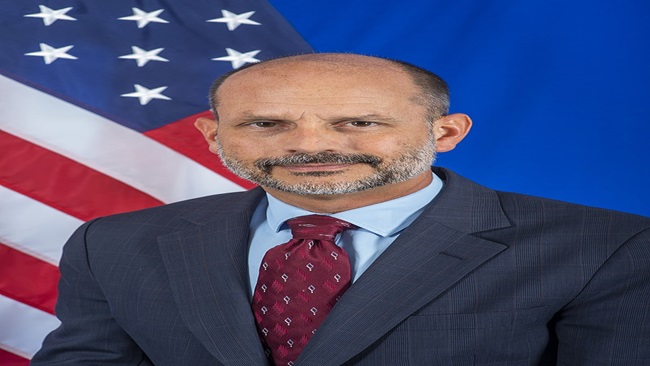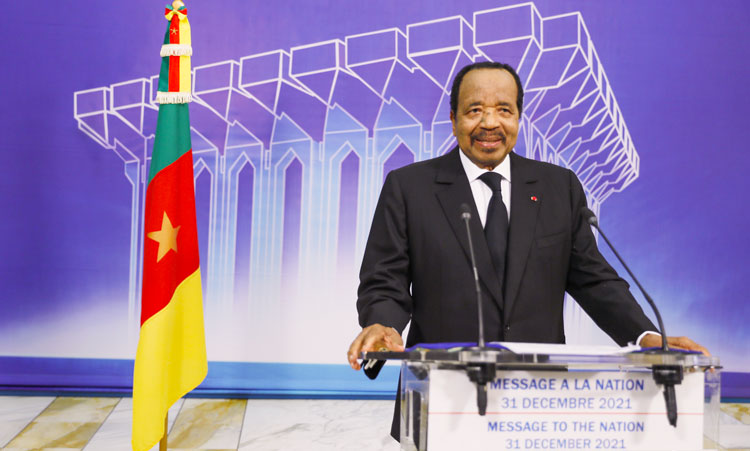Categories
Recent Posts
- CPDM Covid Scandal: Prosecutor seeks 10-Year ban for 4 officials
- Cameroon still faces power cuts despite full output from Nachtigal Dam
- Financial scandal rocks Mkpot Oil Mill Project!! Manyu Chiefs won’t talk
- Yaoundé: Defense Ministry says “Clear Alliance” between Boko Haram and criminals in recent attack
- Football: MTN Elite One resumes after boycott threats
Archives
- March 2025
- February 2025
- January 2025
- December 2024
- November 2024
- October 2024
- September 2024
- August 2024
- July 2024
- June 2024
- May 2024
- April 2024
- March 2024
- February 2024
- January 2024
- December 2023
- November 2023
- October 2023
- September 2023
- August 2023
- July 2023
- June 2023
- May 2023
- April 2023
- March 2023
- February 2023
- January 2023
- December 2022
- November 2022
- October 2022
- September 2022
- August 2022
- July 2022
- June 2022
- May 2022
- April 2022
- March 2022
- February 2022
- January 2022
- December 2021
- November 2021
- October 2021
- September 2021
- August 2021
- July 2021
- June 2021
- May 2021
- April 2021
- March 2021
- February 2021
- January 2021
- December 2020
- November 2020
- October 2020
- September 2020
- August 2020
- July 2020
- June 2020
- May 2020
- April 2020
- March 2020
- February 2020
- January 2020
- December 2019
- November 2019
- October 2019
- September 2019
- August 2019
- July 2019
- June 2019
- May 2019
- April 2019
- March 2019
- February 2019
- January 2019
- December 2018
- November 2018
- October 2018
- September 2018
- August 2018
- July 2018
- June 2018
- May 2018
- April 2018
- March 2018
- February 2018
- January 2018
- December 2017
- November 2017
- October 2017
- September 2017
- August 2017
- July 2017
- June 2017
- May 2017
- April 2017
- March 2017
- February 2017
- January 2017
- December 2016
- November 2016
- October 2016
- September 2016
- August 2016
- July 2016
- June 2016
Featured
Most Commented Posts
 4 Anglophone detainees killed in Yaounde
4 Anglophone detainees killed in Yaounde
18 comments Chantal Biya says she will return to Cameroon if General Ivo Yenwo, Martin Belinga Eboutou and Ferdinand Ngoh Ngoh are sacked
Chantal Biya says she will return to Cameroon if General Ivo Yenwo, Martin Belinga Eboutou and Ferdinand Ngoh Ngoh are sacked
13 comments The Anglophone Problem – When Facts don’t Lie
The Anglophone Problem – When Facts don’t Lie
12 comments Anglophone Nationalism: Barrister Eyambe says “hidden plans are at work”
Anglophone Nationalism: Barrister Eyambe says “hidden plans are at work”
12 comments Largest wave of arrest by BIR in Bamenda
Largest wave of arrest by BIR in Bamenda
10 comments
Latest Tweets
Featured
-

CPDM Covid Scandal: Prosecutor seeks 10-Year ban for 4 officials
-

Cameroon still faces power cuts despite full output from Nachtigal Dam
-

Financial scandal rocks Mkpot Oil Mill Project!! Manyu Chiefs won’t talk
-

Yaoundé: Defense Ministry says “Clear Alliance” between Boko Haram and criminals in recent attack
-

Football: MTN Elite One resumes after boycott threats
-

Biya’s election season stirs renewed anxiety in Southern Cameroons
-

Revealed: Boko Haram fighters kill 20 Cameroonian troops
© Cameroon Concord News 2025





17, November 2024
Fitch Keeps Cameroon at ‘B’ with Negative Outlook 0
Fitch Ratings has affirmed Cameroon’s long-term foreign currency issuer default rating (IDR) at ‘B’ with a negative outlook. In a note, Fitch revealed that the negative reflects political risks related to potential succession issues and structural weaknesses in public finance management (PFM).
This is evidenced by weak liquidity management, late external debt payments, and accumulation of domestic arrears, according to the rating note. Cameroon’s ratings are supported by its resilient GDP growth, a manageable debt maturity schedule and expectations that moderate budget deficits and debt levels will be supported by non-oil revenue mobilization and spending restraint.
Analysts added that this is balanced against low GDP per capita, weak governance indicators, and persistent security challenges. The 92-year-old President Paul Biya, in power since 1982, will likely run in the presidential election, scheduled for October 2025, Fitch said.
The rating note stated that social and political tensions could increase in the run-up to the election, increasing concerns about Cameroon’s political stability, policy continuity and commitment to reform – which underpin bilateral support.
The lack of a succession plan and political divisions and rivalries within the ruling party exacerbate the risk of a disorderly transition of power. The rating note revealed that the country’s weaknesses in budget planning and execution, and debt management weigh on the rating.
The government’s exceptional spending procedures remain high, albeit declining, due to constant unexpected security spending and liquidity pressures. PFM weaknesses are evidenced by occasional late external debt service payments.
It was revealed in July that Cameroon was late in making external debt payments to one commercial creditor in March 2024. Moreover, in 2024, Cameroon has cleared XAF467 billion of domestic arrears using proceeds of a private placement issuance and resources lent by Afreximbank.
“We see continued risk of arrears accumulation given a projected financing shortfall”, Fitch Ratings said amidst country’s tight finance.
In 2004, Cameroon is unlikely to obtain budgeted financing from the World Bank of USD200 million, due to delays in implementing structural reforms, Fitch stated.
Analysts explained that the projected shortfall in financing will be compensated by spending cuts. The funds could be disbursed in 2025, but the electoral context may further slow reform implementation.
“Nevertheless, we expect Cameroon’s funding needs will be covered through the existing IMF programme, ending June 2025, and official creditor support tied to the completion of the reviews”.
The government will also rely on the regional bond market.
Fitch baseline assumes strong support from official creditors will continue over the medium term, with a potential renewal of the IMF programme in 2026, which is key for the financing plan. Cameroon has limited fiscal room, and fiscal consolidation is being driven by spending cuts, mainly on capex under-execution.
“We forecast the fiscal balance on a commitment basis will shift to a surplus of 0.1% of GDP in 2024, remaining broadly stable in 2025-2026.
“Oil revenues will decline due to lower oil prices and production, but non-oil revenues will continue to improve through revenue mobilisation measures, tax exemptions reduction, and improvement in tax and customs administrations”.
Fitch also forecast the fiscal deficit on a cash basis to widen from 0.4% of GDP in 2023 to 1.6% in 2024, as net repayment of arrears is expected at 1.7% of GDP at end-2024.
“We expect the cash deficit will decline to 0.7% of GDP in 2025 and 0.6% in 2026, although the pace of net repayment of arrears casts uncertainty on the fiscal trajectory”. The government is committed to reduce fuel subsidies, increasing retail petroleum prices in 2024 by 15%, after a 21% rise in 2023.
However, given the importance of social stability and the presidential election, we assume the government will not increase petroleum prices in 2025, delaying the phasing out of fuel subsidies.
“We estimate fiscal financing needs, at 5.7% of GDP in 2024, will decline to 4.7% of GDP in 2025, owing to lower cash deficit and arrears repayment. We project fiscal financing needs will increase to 5.4% of GDP in 2026 as domestic debt amortisation will amount to 2.6% of GDP after 2.1% in 2024.
“External debt amortisation will increase from 2.0% of GDP in 2024 to 2.1% in 2025 and 2.2% in 2026, including Eurobond payment at 0.1% of GDP per year”. Fitch project GDP growth and moderate cash budget deficits will maintain government debt on a declining path from 41.7% of GDP in 2023 to 36.3% in 2026, below the ‘B’ median forecast of 56.4%.
Also, analysts expect real GDP growth to increase to 3.7% in 2024 from 3.2% in 2023. “We forecast growth at 4.0% in 2025 and 4.1% in 2026, driven by agriculture, construction, and the coming on-stream of infrastructure and electricity projects, below the ‘B’ median forecast of 4.7%”.
Downside risks to growth stem from geopolitical uncertainties leading to renewed commodity price volatility, supply chain disruptions, and inflationary pressures. The 2025 presidential election threatens reform implementation and increases security and social risks.
Analysts forecast the current account deficit (CAD) to narrow from 4.1% of GDP in 2023 to 3.6% of GDP in 2024 owing to higher cocoa prices supporting exports. Fitch projects the CAD will fall to 3.2% of GDP in 2025-2026, as the decline in oil production will be offset by the implementation of the import substitution policy, while exports will increase thanks to stronger agricultural production.
Source: dmarketforces